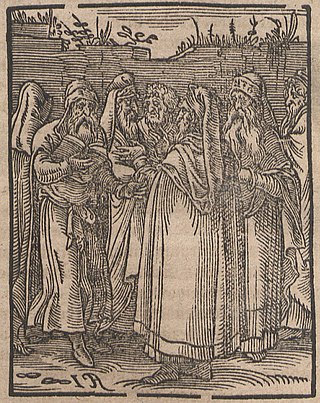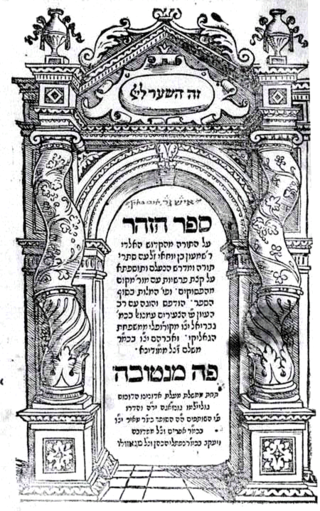
Kabbalah or Qabalah is an esoteric method, discipline and school of thought in Jewish mysticism. A traditional Kabbalist is called a Mekubbal. The definition of Kabbalah varies according to the tradition and aims of those following it, from its origin in medieval Judaism to its later adaptations in Western esotericism. Jewish Kabbalah is a set of esoteric teachings meant to explain the relationship between the unchanging, eternal God—the mysterious Ein Sof —and the mortal, finite universe. It forms the foundation of mystical religious interpretations within Judaism.

The Zohar is a foundational work of Kabbalistic literature. It is a group of books including commentary on the mystical aspects of the Torah and scriptural interpretations as well as material on mysticism, mythical cosmogony, and mystical psychology. The Zohar contains discussions of the nature of God, the origin and structure of the universe, the nature of souls, redemption, the relationship of Ego to Darkness and "true self" to "The Light of God".

Metatron, or Matatron, is an angel in Judaism, Christianity, and Islam mentioned three times in the Talmud, in a few brief passages in the Aggadah, and in mystical Kabbalistic texts within Rabbinic literature. The figure forms one of the traces for the presence of dualist proclivities in the otherwise monotheistic visions of both the Tanakh and later Christian doctrine. In the Jewish kabbalistic tradition, he is sometimes portrayed as serving as the celestial scribe. The name Metatron is not mentioned in the Torah or the Bible, and how the name originated is a matter of debate. In Islamic tradition, he is also known as Mīṭaṭrūn, the angel of the veil.

Isaac ben Solomon Luria Ashkenazi, commonly known in Jewish religious circles as Ha'ari, Ha'ari Hakadosh or Arizal, was a leading rabbi and Jewish mystic in the community of Safed in the Galilee region of Ottoman Syria, now Israel. He is considered the father of contemporary Kabbalah, his teachings being referred to as Lurianic Kabbalah.

Moshe Chaim Luzzatto, also known by the Hebrew acronym RaMCHaL, was a prominent Italian Jewish rabbi, kabbalist, and philosopher.
Academic study of Jewish mysticism, especially since Gershom Scholem's Major Trends in Jewish Mysticism (1941), draws distinctions between different forms of mysticism which were practiced in different eras of Jewish history. Of these, Kabbalah, which emerged in 12th-century southwestern Europe, is the most well known, but it is not the only typological form, nor was it the first form which emerged. Among the previous forms were Merkabah mysticism, and Ashkenazi Hasidim around the time of the emergence of Kabbalah.
Bahir or Sefer HaBahir is an anonymous mystical work, attributed to a 1st-century rabbinic sage Nehunya ben HaKanah because it begins with the words, "R. Nehunya ben HaKanah said". It is also known as Midrash of Rabbi Nehunya ben HaKanahמִדְרָשׁ רַבִּי נְחוּנְיָא בֶּן הַקָּנָה.

Moses ben Jacob Cordovero was a central figure in the historical development of Kabbalah, leader of a mystical school in 16th-century Safed, Ottoman Syria. He is known by the acronym the Ramak.

Rabbi Yehuda Ashlag (1885–1954) or Yehuda Leib Ha-Levi Ashlag, also known as the Baal Ha-Sulam in reference to his magnum opus, was an orthodox rabbi and kabbalist born in Łuków, Congress Poland, Russian Empire, to a family of scholars connected to the Hasidic courts of Porisov and Belz. Rabbi Ashlag lived in the Holy Land from 1922 until his death in 1954. In addition to his Sulam commentary on the Zohar, his other primary work, Talmud Eser Sefirot is regarded as the central textbook for students of Kabbalah. Ashlag systematically interpreted the wisdom and promoted its wide dissemination. In line with his directives, many contemporary adherents of Ashlag's teachings strive to spread Kabbalah to the masses.

Eliyahu de Vidas was a 16th-century rabbi in Ottoman Palestine. He was primarily a disciple of Rabbis Moses ben Jacob Cordovero and also Isaac Luria. De Vidas is known for his expertise in the Kabbalah. He wrote Reshit Chochmah, or "The Beginning of Wisdom," a pietistic work that is still widely studied by Orthodox Jews today. Just as his teacher Rabbi Moses Cordovero created an ethical work according to kabbalistic principles in his Tomer Devorah, Rabbi de Vidas created an even more expansive work on the spiritual life with his Reishit Chochmah. This magnum opus is largely based on the Zohar, but also reflects a wide range of traditional sources. The author lived in Safed and Hebron, and was one of a group of prominent kabbalists living in Hebron during the late 16th and early 17th-century.
Hayyim ben Joseph Vital was a rabbi in Safed and the foremost disciple of Isaac Luria. He recorded much of his master's teachings. After Vital's death, his writings began to spread and led to a "powerful impact on various circles throughout the Jewish world."

Elia del Medigo, also called Elijah Delmedigo or Elias ben Moise del Medigo and sometimes known to his contemporaries as Helias Hebreus Cretensis or in Hebrew Elijah Mi-Qandia. According to Jacob Joshua Ross, "while the non-Jewish students of Delmedigo may have classified him as an “Averroist”, he clearly saw himself as a follower of Maimonides". But, according to other scholars, Delmedigo was clearly a strong follower of Averroes' doctrines, even the more radical ones: unity of intellect, eternity of the world, autonomy of reason from the boundaries of revealed religion.
Isaac ben Samuel of Acre was a Jewish kabbalist who fled to Spain.
The primary texts of Kabbalah were allegedly once part of an ongoing oral tradition. The written texts are obscure and difficult for readers who are unfamiliar with Jewish spirituality which assumes extensive knowledge of the Tanakh, Midrash and halakha.
Judaism and environmentalism intersect on many levels. The natural world plays a central role in Jewish law, literature, liturgy, and other practices. Within the arena of Jewish thought, beliefs vary widely about the human relationship to the environment.
Botsina means lantern, lamp, torch, or spark in Aramaic. Many times the reference, in Jewish sources, is to that which enlightens spiritually.
In the teachings of Rabbi Isaac Luria, it is said that there are many Liliths. Manasseh Matlub Sithon said "many Liliths and demons are abroad, and go up and down."
Patach Eliyahu, also called Petihat Eliyahu HaNavi, is an Aramaic, Kabbalistic discourse from the introduction to Tikunei Zohar 17a. It is named after its initial words, where it is attributed to Elijah the Prophet. Considered a foundational text of Kabbalah, Patach Eliyahu is known for enumerating and summarizing the sefirot, corresponding them to parts of the body, and describing the infiniteness and uniqueness of God.

Boaz Huss is a professor of Kabbalah at the Goldstein-Goren Department of Jewish Thought at Ben-Gurion University of the Negev. He is a leading scholar in contemporary Kabbalah.









